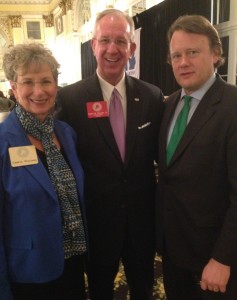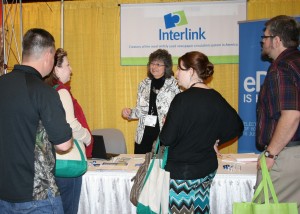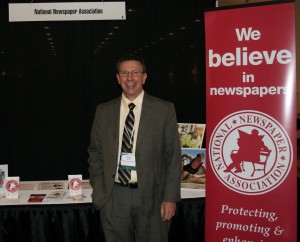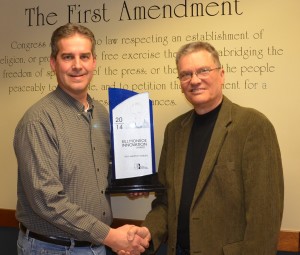
March 2014 Community Journal Newsletter
NNA members in D.C. for ‘We believe in newspapers’ summit
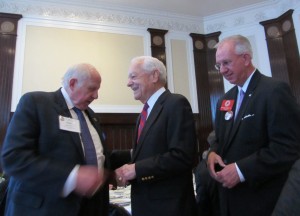 NNA members from around the country converged on Washington, D.C. on March 13 for the “We Believe in Newspapers” Leadership Conference and Postal Summit. After a group session, members headed to Capitol Hill to visit their representatives and senators to discuss issues important to the community newspaper industry. Postal changes, including the possibility of the United State Postal Service dropping Saturday mail and the possible end of Postal Regulatory Commission oversight of USPS, and the handling of advertising deductions as a business expense were high on the group’s list this year. The day ended with Bob Schieffer, CBS anchor and moderator of Face the Nation, addressing the group at a dinner at the National Press Club. Schieffer, a friend of NNA President Robert Williams, is shown above, center, with Williams, right, and Nebraska Press Association Executive Director Allen Beermann as he arrived at the Press Club prior to the dinner. For more photos from the ‘We Believe in Newspapers Summit’, click here. Interlink photo/Helen Sosniecki
NNA members from around the country converged on Washington, D.C. on March 13 for the “We Believe in Newspapers” Leadership Conference and Postal Summit. After a group session, members headed to Capitol Hill to visit their representatives and senators to discuss issues important to the community newspaper industry. Postal changes, including the possibility of the United State Postal Service dropping Saturday mail and the possible end of Postal Regulatory Commission oversight of USPS, and the handling of advertising deductions as a business expense were high on the group’s list this year. The day ended with Bob Schieffer, CBS anchor and moderator of Face the Nation, addressing the group at a dinner at the National Press Club. Schieffer, a friend of NNA President Robert Williams, is shown above, center, with Williams, right, and Nebraska Press Association Executive Director Allen Beermann as he arrived at the Press Club prior to the dinner. For more photos from the ‘We Believe in Newspapers Summit’, click here. Interlink photo/Helen Sosniecki
Subscriptions: Expanding that revenue source may be easier than you think
 By William E. (Bill) Garber
By William E. (Bill) Garber
Founder
Time to risk something new?
How about more of the same?
It’s a lot easier than changing!
And, in at least one substantial way, much more promising.
Newspapers have been around for centuries.
Their user interface was perfected before anyone came up with the words, user interface.
So what’s different these days?
Remember when publishers had had time to have that second cup of coffee with readers and advertisers at the coffee shop several times a week?
Churches were full. Schools were a little too full. And, the classified pages were bulging to overflowing.
Publishers weren’t wealthy, though their passion for community lived through the pages of their paper, a business that promised steady income and, in time, a well-deserved retirement.
What a story!
Times have changed
To be brief, classifieds are scattered, small businesses are fewer, and people are distracted by gadgets spewing infotainment on demand.
Publishers know every advertiser and potential advertiser in town in part because there are fewer of them. Services have migrated to businesses only larger communities can sustain, and even there, the economy is checkered at best.
The bright glow remaining is the loyalty of subscribers returning the favor of publishers loyal to their communities. Take that as a compliment, one threatened in the main only by the moving van and the undertaker.
Now
So what now?
Where are we going to find that new revenue base?
Subscriptions have always been a newspaper’s most reliable revenue.
The most interesting thing is that subscriptions are also today’s largest-scale opportunity for growing immediate and recurring revenue at community newspapers everywhere.
Non-subscriber households frequently outnumber subscriber households, so the opportunity may well be twice the current subscription revenue at these papers.
That is why we are focusing on refining and simplifying Interlink’s until now quiet little Smart Sampling™ service. This newly improved service reduces the cost to acquire new subscriptions to an all-time low.
Smart Sampling™ is now by far the easiest and most successful systematic method of increasing reliable subscription revenue in the history of newspapering.
This is why Smart Sampling™ may well be the most-important tool in any community newspaper revenue growth plan.
Here is how the new, improved Smart Sampling™ will work for you.
“Smart Sampling” distinguishes between subscriber copies and non-subscriber copies.
This makes it easy to automatically insert special sample copy explanations and subscription offers exclusively in newspapers sent to non-subscriber addresses.
Until Smart Sampling™ you really had no other option but to flood both subscriber and non-subscriber copies with the same new sub offers. So Smart Sampling™ eliminates 100% of both the cost and the confusion by eliminating these materials in subscriber copies.
Of course, you tell your community’s story better than anyone. Always have. Always will.
Now with Smart Sampling™ it has never been so easy or inexpensive to help non-subscribers catch the habit subscribers love, and go ahead and add their names to your subscriber list.
Coming May, Interlink will be releasing our new Smart Sampling™ to community newspapers ‘across the fruited plain’ to help you spread your story and grow your business.
We can hardly wait!
NNA President visits Michigan
Robert Williams, center, president of the National Newspaper Association, and his wife, Cheryl, visit with Michael MacLaren, executive director of Michigan Press Association, during the MPA’s annual convention Jan. 31-Feb. 1 in Grand Rapids. Williams is publisher of the Blackshear Times in Georgia. Interlink photo/Brad Hill
Interlink expands electronic postage statement support to Standard Mail
We are pleased to announce that with the February release of Interlink Circulation version 2.3.13, support was added for electronically submitting USPS Form 3602, the postage statement for Standard Mail.
For several months, Interlink Circulation has supported online submission of USPS Form 3541 Postage Statements, eliminating the need for hardcopy forms to be present when mail is entered at a post office. Reports from those who have made the switch to eDoc (Electronic Documentation) are positive, citing convenience as the primary benefit. However, adoption has been slower than we had hoped due to a series of problems with USPS back-end systems.
When new postage rates took effect on Jan. 26, USPS released a major update to PostalOne! to support the change. That update also included fixes for a number of known issues, but, unfortunately, it introduced several new ones at the same time.
The most prominent new problem related to how the preferred price discount was calculated for periodical mail. After the update, PostalOne! incorrectly offered some mailers too high of a discount, reducing the total postage due to less than it should have been. That may sound like a miracle more than a disaster, but, in fact, this discrepancy resulted in many threats to hold mail by postal employees who were unsure of how to handle the difference. Information released from USPS Headquarters eventually advised postal personnel of the proper procedure.
To avoid falling victim to issues such as this, eDoc users should log into the USPS Business Customer Gateway at gateway.usps.com after submitting their eDoc, and compare the postage totals shown online against the front page of a hard-copy postage statement.
Despite a series of bugs and setbacks related to eDoc, Interlink encourages Circulation users to take steps to configure and test using electronic documentation with their lists as soon as possible. In addition to the immediate benefits of convenience to both mailers and postal workers, reduced time to deposit mail, and increased accuracy (when working properly), eDoc remains a core requirement of Full-Service Intelligent Mail, which was only delayed, not cancelled.
For information on how to begin using eDoc, or for assistance with any issues along the way, contact Interlink’s Client Solutions team by phone at (888) 473-3103, or send an email to support@ilsw.com.
Discussing circulation in Texas
Helen Sosniecki, Interlink’s Senior Sales and Marketing Manager, above center, visits with Texas Press Association members during the TPA’s recent Mid-Winter Conference and Trade Show. Sosniecki and Angela Kurtz, Interlink’s Associate Marketing Manager, visited with dozens of customers and potential customers during the two-day tradeshow held in Frisco. Texas is Interlink’s largest customer state. To view more photos from TPA, click here. Interlink photo/Angela Kurtz
Mail shouldn’t be run like a business
By Eric Meyer, Publisher
Marion County (KS) Record
Reprinted with permission
The only thing more certain than death and taxes is the U.S. Postal Service asking for yet another rate increase.
It’s high time Washington put a stamp of disapproval on our mail system’s continual whining and perhaps even rethink the whole idea of making the Postal Service “run like a business.”
In this case, of course, the “business” would go broke in less time that it takes for a letter to get from Marion to Hillsboro. In fact, founding postmaster general Ben Franklin, not exactly a bashful type, would be red-faced with embarrassment to see how poorly his old post office has delivered on its promises and how miserably it has failed to heed one of his favorite adages: “By failing to prepare, you are preparing to fail.”
We have nothing but the deepest appreciation for local postal officials, who frequently go far out of their way to be of service to the people who pay their salaries. What’s rotten is in Washington, where the “run it like a business” concept has led to cockeyed innovations that invariably cost more while providing less.
The situation is so bad that if you subscribe to our papers through the mail, you might not get a chance to read this until two or three more rounds of postal rate increases are proposed. Personally, I received last week’s Marion County Record and Peabody Gazette-Bulletin on Saturday, pretty much on schedule by current postal standards — even though a few years ago they would have arrived on Friday.
The problem is that the following Monday, two days later, I received the previous week’s Marion and Peabody papers, now 12 days old. Worse yet, as of Monday, the most recent Hillsboro Star-Journal I had received was the Jan. 1 issue. That’s right. I was still waiting on Feb. 3 for the Jan. 8, Jan. 15, Jan. 22, and Jan. 29 issues. From what we hear, that isn’t much different from what other subscribers are forced to endure, especially with mail that goes through the Hillsboro area’s sectional center, where the latest and definitely not greatest in cost-saving “advances” instituted by the Postal Service have occurred.
Trust us, folks. If we could do something about it, we would. We’re as angry as — well —disgruntled postal workers about how messed up our subscribers’ mail has become. Mail that people actually want to receive — periodicals they’ve paid for —– seems to arrive whenever postal workers have absolutely nothing else to do.
What does show up on time — whether you want it or not — is piles and piles of junk mail you never asked for.
Why? Because the Postal Service is trying to curry favor with junk mailers, making it easier and easier for them to get timely delivery of their cut-rate mailings. It’s how the Postal Service is trying to run itself “like a business.”
Let’s ignore the stupidity that if we mail something to the Courthouse across the street from our offices, the mail goes first to Kansas City, then back. If we mail something from Marion to Tampa it goes on a grand tour that might well see it stop over for a few days in Kansas City, Wichita, and even Salina. It used to be that someone from the Marion or Hillsboro office just drove the mail 10 miles to the other town. “Running it like a business” put a stop to that.
There’s nothing inherently wrong with wanting to be businesslike. What’s fundamentally wrong is that the Postal Service never was intended to be a business. Make it a business and the first thing it’ll want to get rid of are deliveries to “non-profitable” areas — code words for basically every rural farmhouse and small-town doorstep in existence. Saturday delivery? Of course not. Walk-up hours at local post offices? Make them no more than 45 minutes, scattered at odd times throughout the day.
Small-town post offices and rural mail delivery are never going to be profitable. Nor will delivering newspapers and magazines people subscribe to. The answer is not to create more and more cumbersome Rube Goldberg systems that never seem to work and then, when they fail, try to compete with private businesses for junk mail distribution in hopes of making enough money to recover costs of universal service.
The Kansas Turnpike is a great example of how “running it like a business” sometimes works. But can you imagine what would happen if all transportation departments nationwide were expected to be run like a business? Rural areas like ours would still have little more than ruts from ox carts instead of highways. And while we all lament the sad state of roads in Marion County, things could be a whole lot worse if every highway had to be justified on the basis of the revenue it brings in.
As a society, we subsidize schools, senior centers, airports, recreational lakes, radio and TV networks, and artists who produce works that many regard as offensive. None of them are run “like a business.” Why should the mail we receive every day be treated that way, especially when the only thing it reliably delivers is junk we never asked for.
These days, when it’s hard to find anything government does that’s actually worth the price, why not subsidize a service we need — the U.S. Postal Service — but only for delivering things people want to locations where they want it?
NNA among exhibitors at Iowa
The National Newspaper Association was among exhibitors at the Iowa Newspaper Association Convention and Trade Show held in February in Des Moines. Missouri publisher Dane Vernon, NNA Region 7 Director, represented NNA at the convention. To see more photos from INA, click here. Interlink photo/Helen Sosniecki
NNA survey: Small town residents depend on their community paper
From National Newspaper Association
COLUMBIA, MO — Two-thirds of residents in small towns across America depend upon their local newspaper for news and information, according to the National Newspaper Association’s most recent newspaper readership survey.
NNA, founded in 1885, represents 2,200 members across the U.S. Its mission is to protect, promote and enhance America’s community newspapers. Most of its members are weekly or small daily newspapers in smaller or niche communities.
The survey noted that more readers are using mobile devices to shop, read and communicate. The number with smartphones jumped from 24 percent to 45 percent and 39 percent said they used the phones to access local news.
Newspaper websites remained the leading provider of local news, followed distantly by a local TV station’s site and then by national aggregators, such as Google and Yahoo.
The annual NNA Community Newspaper Readership survey was completed in 2013 in partnership with the Center for Advanced Social Research of the Reynolds Journalism Institute at the University of Missouri. Surveyors reached 508 households in communities where a local newspaper of circulation of 15,000 or less served the communities. The survey began in 2005. It has consistently shown the community newspaper to be the information leader in smaller communities.
Trust in the local newspaper remains high, the survey found.
Overall, readers in the 2013 survey gave high ratings to the accuracy, coverage, quality of writing and fairness of news reporting of the local print newspapers. In “coverage of local news,” “quality of writing” and “fairness of reporting,” their combined ratings were higher than in 2012.
- 94% of readers agreed that the newspapers were informative.
- 80% said that they and their families looked forward to reading the newspapers.
- 78% relied on the newspapers for local news and information.
- 72% said the newspapers entertained them.
Local readers also like to share their newspaper with others. The “pass-along rate” of the primary subscriber’s sharing with others rose in 2013 to 2.48, compared to 2.18 in 2012 and 2.33 in 2011, possibly indicating continued economic pressure from the fallout of the Great Recession as families economize by purchasing fewer individual copies.
Striking was the finding that nearly one-third of households still do not have Internet access at home. The finding parallels similar conclusions from the U.S. Census Bureau and others that continue to report slow growth in Internet penetration across smaller, and particularly rural communities.
NNA President Robert M. Williams Jr., publisher of the Blackshear (GA) Times, remarked that the RJI research consistently shows the community newspaper as the dominant information medium in their communities.
“We know that it is very difficult for a good community to survive without a good newspaper and vice versa,” Williams said. “The high levels of trust, the consistent pass-along rate and the desire to find the newspaper in whatever medium the reader wishes to use—whether mobile, print or Web—demonstrate the value of good community journalism.”
Williams’ theme during his presidency has been the interdependency of local communities and local newspapers.
“As I often say, if you want a Big Mac, you go to McDonald’s. If you want local news in Blackshear, you go to the Blackshear Times. That high quality news franchise is replicated across America—particularly in smaller communities—in ways that electronic media can only enhance, not supplant. As our electronic mission develops, we remain strong in print and proud of it. We are thankful for America’s readers, who use our news and information and make our communities strong,” he said.
Jerry Lyles with Athlon Media Group, said “Newspapers are the eyes, ears and hearts of communities across America. They provide local news and information important to their residents that can’t be found anywhere else.”
Interlink founder and owner Bill Garber said, “This year’s NNA research confirms that the newspaper itself remains, by a wider margin, the most preferred and trusted source for local news and information as well as advertising.”
“Like readers everywhere, Interlink values community newspapers; and like publishers everywhere, we value community newspaper readers, too.
“That is why this year, and well before the U.S. Postal Service regroups to require it, we will bring proven Full-Service Intelligent Mail® delivery superiority to every newspaper subscriber that every one of our clients mail to wherever they live and work,” Garber added.
“As the NNA study also proves, newspapers today don’t need to be different or better to attract more subscribers. People like the paper well enough just the way it is! Not that better isn’t—well, better. And not that with more readers publishers aren’t likely to invest in making their papers better for both their readers and their advertisers. As the study proves and as publishers are proving every week, new subscribers are signing up every day.”
Interlink President Brad Hill concurs: “We salute NNA and its member publishers for being truly successful under what has been for some time less than an ideal economy,” Hill said, adding that Interlink is proud to be an NNA Partner and proud to help support NNA’s readership survey.
“Interlink believes in the strength of community newspapers. Nothing connects the people of a small community like their local newspaper,” added Hill, who is an NNA representative on the Postmaster General’s Mailers’ Technical Advisory Committee.
Full survey results are available to NNA member newspapers at www.nnaweb.org.
USPS says newspaper mail can stay at local PO
From National Newspaper Association
A new directive from the U.S. Postal Service headquarters to mail processing plants and local post offices is expected to improve newspaper delivery, the National Newspaper Association said Feb. 7.
USPS released to NNA an internal operating policy intended to stop local post offices from unnecessarily sending 5-digit containers of newspaper mail to mail processing plants.
The directive tells local postmasters that newspapers already prepared for local delivery should be held at the local post offices or sent to other area post offices through operating “hubs,” many of them former SCFs, rather than slowing delivery by sending them along for processing at distant, merged plants.
“Transporting these containers of direct 5-digit local newspapers to upstream processing center(s) only to have the processing center dispatch them back to the AOs (associate offices) results in unnecessary transportation and handling costs and can lead to service delays,” the directive stated.
The new statement resulted from requests by NNA to USPS in July 2013, as NNA leadership began a series of meetings with the postmaster general and his senior staff to address chronic and serious newspaper delivery problems.
“We are heartened that the Postal Service has explicitly stated this policy so we can avoid confusion in local post offices,” NNA President Robert M. Williams Jr. said. “When we met with Postmaster General Patrick Donahoe and his management team, fixing the delivery delays coming from unnecessary transportation of our mail was our top priority. We are pleased that the Postal Service addressed the problem. We hope now to get the word out so that our members can tackle some of our most vexing problems and we look forward to working with Donahoe on other service concerns.”
Max Heath, NNA Postal Committee chairman, said an outbreak of delivery delays from unnecessarily transported newspaper containers stemmed from a combination of sources.
“First, a lot of processing plants that used to handle our mail closed down, resulting in new directives for transportation in the field. That confused a lot of postmasters about where mail should go. Second, retirements of seasoned postmasters brought in a lot of new people who were not familiar with our mail and the new recruits felt they needed to adhere to USPS policy to direct more mail to plants —even when that is superfluous for our local mail. Finally, the ogre of Sarbanes-Oxley compliance that fell upon USPS thanks to the 2006 Congress has made a lot of otherwise very sensible postal officials fear they will be sanctioned unless they do everything exactly by the book. So we decided what we needed to do was make sure ‘the book’ was written correctly,” Heath said.
“Direct” containers include 5-digit, carrier-route, or M5D (merged 5-digit and carrier-route), the policy explains.
The directive has been distributed to all USPS area vice presidents, over the signature of USPS Vice President of Operations David E. Williams and Delivery and Post Office Operations Vice President Edward E. Phelan, Jr. It defines the containers covered for the local holdout as 5-digit, carrier route or Merged 5D-Carrier Route containers.
A copy of the policy directive is available to NNA members at www.nnaweb.org.
Take a bow…
Rhoades receives Publisher Award at Iowa convention
Mark Rhoades with family members after receiving a Master Editor-Publisher Award at the Iowa convention. Photo supplied by Enterprise Publishing
Mark Rhoades, president of Enterprise Publishing Co., was honored with a Master Editor-Publisher Award at the Iowa Newspaper Association Convention in February in Des Moines.
Rhoades was cited for his dedication to the industry as illustrated not only through the multiple newspapers he leads but also through his active community involvement. In the announcement, it was noted that “his leadership and initiative have resulted in strong newspapers serving their communities for the past 30 years.”
Rhoades was born into a newspaper family and was active during his youth in the print shop, helping with any odd jobs he could find. After college, he returned to the family business and began learning about all aspects of the industry.
In introducing Rhoades, it was noted that “He is a friend to his peers, always helping out when a neighbor paper needs a hand. While those who operate central printing plants compete with one another, our recipient never hesitates to offer his services when a fellow printer has an equipment malfunction, natural disaster or staffing issue.”
He was praised for looking for growth opportunities for his company, acquiring newspapers and launching a specialized division which focuses on niche marketing. In addition to responsibilities as publisher, he spends many hours each month helping out his hometown through various community groups including Rotary and the YMCA.
Rhoades has been an active member of the Iowa Newspaper Association, having served as president, and its Foundation, as well as the Nebraska Press Association. He currently serves as president of his company and publisher of 12 newspapers including the Missouri Valley Times-News and Mapleton Press in Iowa.
Tribune wins Innovation Award
Dave Stanley, owner of the New Hampton (IA) Tribune, left, receives the 2014 INA Bill Monroe Innovation Award from the award’s namesake. Photo supplied by New Hampton Tribune
From New Hampton Tribune
Reprinted with permission
The New Hampton Tribune for a second straight year has taken home one of the highest honors the Iowa Newspaper Association bestows.
During February’s annual INA Convention, the Tribune was named the winner of the Bill Monroe INA Innovation Award for its work on helping raise funds for the Chickasaw County Veterans Memorial.
“I couldn’t be prouder of our staff and our community for coming together on this project,” Tribune Publisher Dave Stanley said. “We wanted to support this worthy cause and we wanted to honor veterans and with this project, we could do both.”
Monroe is the former executive director of the INA, which includes hundreds of newspapers throughout the state.
In the fall of 2012, as fundraising work was just beginning on the memorial, Stanley announced the newspaper would donate the $5 fee it usually charged to display a veteran’s picture in the paper’s Veterans Day special section to the memorial committee and that the Tribune would match up to $1,000.
The newspaper ran several news stories and editorials on the project and in November 2012 published a Veterans Day special section that included pictures of 227 veterans, which led to a $2,135 donation to the Veterans Memorial Committee. By comparison, the November 2011 Veterans Day pages had just 21 veterans.
Circulation service honors Max Heath
NNA Postal Committee Chairman Max Heath recently was honored by the LEARNing More Circulation Idea Service, owned by Steve and Christie Learn, with selection to their Anderson-Hanna National Circulation Director Hall of Fame.
In the announcement, Steve Learn said of Heath, “Max was a main cog in the circulation growth area within his group (LCNI) and is well known to circulation directors across the country for his expertise in the postal arena. No one could break down a postal issue and offer up a solution better than Max.”
Interlink Circulation Trade Show Winners
In Texas
Brandi Guy, Executive Vice-President of Granite Publications, right, is congratulated by Interlink Senior Sales and Marketing Manager Helen Sosniecki for winning an Interlink Circulation conversion during the Texas Press Association Mid-Winter Conference in Frisco. At left is Dale Buie, publisher of Granite’s recent acquisition, the Light and Champion in Center. Tammy Prout, publisher of Hill Country Community Journal, won the half-price conversion. (See more photos from the Texas conference here.) Interlink photo/Angela Kurtz
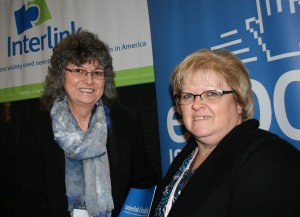
In Iowa
Donna Forsyth, publisher of the Griswold American, right, is congratulated by Interlink Senior Sales and Marketing Manager Helen Sosniecki for winning an Interlink Circulation conversion during the Iowa Newspaper Association Convention and Trade Show in Des Moines. Kristy Lonsdale, publisher of the Stuart Herald, won the half-price conversion. (See more photos from the Iowa convention here.) Interlink photo
Share your good news
Send news about your company or staff awards and accomplishments to share in our next quarterly Interlink Community Journal. Email them to helen@ilsw.com or angela@ilsw.com
What our customers are saying…
From Tennessee…
“Seems like you guys really looked at everything when you put the program together. It’s easy to navigate and training is spectacular. Thank you, thank you, thank you! It thinks of everything for me. Seems to be working well for the post office, as well. I don’t have to think about anything except entering the right information.”
Marne Carroll
Lewis County Herald
Hohenwald, TN
From Oklahoma…
“Interlink’s Print to Mail renewal service saves us a lot of time. Other publishers should give it a try!”
Steve Kizziar
Mustang Times
Mustang, OK
From Nebraska…
“Everything is going wonderfully! Our post office is just in love with us, and the program was easy to pick up and make the transition.”
Alisha Stone
Northeast Nebraska News
Hartington, NE
Interesting links…
An all-to-real video about conference calls
Anyone who has ever participated in a conference call probably can find something they recognize in this funny video about conference calls. http://www.youtube.com/watch?v=DYu_bGbZiiQ
Interview warns about going to online-only
Publishers considering an online-only option may want to read this Mr. Magazine™ Interview with Dr. Robert Magee, Assistant Professor, Virginia Tech State University
about ceasing a print publication in favor of online-only publication before making a decision. http://mrmagazine.wordpress.com/2014/01/27/warning-do-not-kill-your-print-publication-before-you-watch-and-read-this/
Growing dependence on circulation revenue
This American Journalism Revenue article reports on the growing dependence on circulation revenue by large newspaper holding companies. http://ajr.org/big-shift-reliance-reader-payments-newspapers/
Writer offers revenue matrix for news outlet
Frederic Filloux writes on Monday Note about a revenue matrix for a modern, content-rich news outlet. He calls it “… a means to capture emerging opportunities and to compensate for the drying up of older revenue sources.” http://www.mondaynote.com/2014/02/23/news-media-revenue-matrix-the-birds-eye-view/
Share your circulation promotions
Have you had a successful circulation-subscription campaign that you would like to share with fellow publishers in the community-newspaper industry? We’d be happy to share them in our next quarterly Interlink Community Journal. They may be emailed to helen@ilsw.com or angela@ilsw.com
Interlink Calendar
Memorial Day
Monday, May 26 – Memorial Day. Office closed.
Postal Calendar
Memorial Day
Monday, May 26. Post offices closed. No mail delivery.
INTERLINK CLASSIFIEDS
SAVE YOUR GAS MONEY from those trips to the office supply store for labels. Let Interlink ship them directly to you. Call 888-473-3103 for pricing.
NEED A NEW LABEL PRINTER? No need to spend your cash buying a new one. Just use Interlink’s Monthly Printer Service. For only $24.95 per month, Interlink will provide you a fully supported thermal label printer for unlimited use in your office. Current model being supplied is the Citizen CL-S621. Label/ribbon packages are available from Interlink. Call 888-473-3103.
FREE TRAINING! Our Spring Special lets three lucky customers keep the standard $190 training fee to stimulate their local economy. We will provide a FREE 2-hour training session to the first three Interlink customers who respond to this ad. Call Helen or Jessica at 888-473-3103. A trained, efficient Interlink Circulation operator can save your newspaper time and money. If you have an operator who has not been through our training process, who learned by sharing information internally with the last operator, chances are not all of the program’s efficiencies are being utilized. If you don’t respond in time to grab one of the free offers, we still can sign your operator up for an intense two-hour training session for only $190. Let us help get your operator up to speed on all Interlink can do to help you and your operation.



